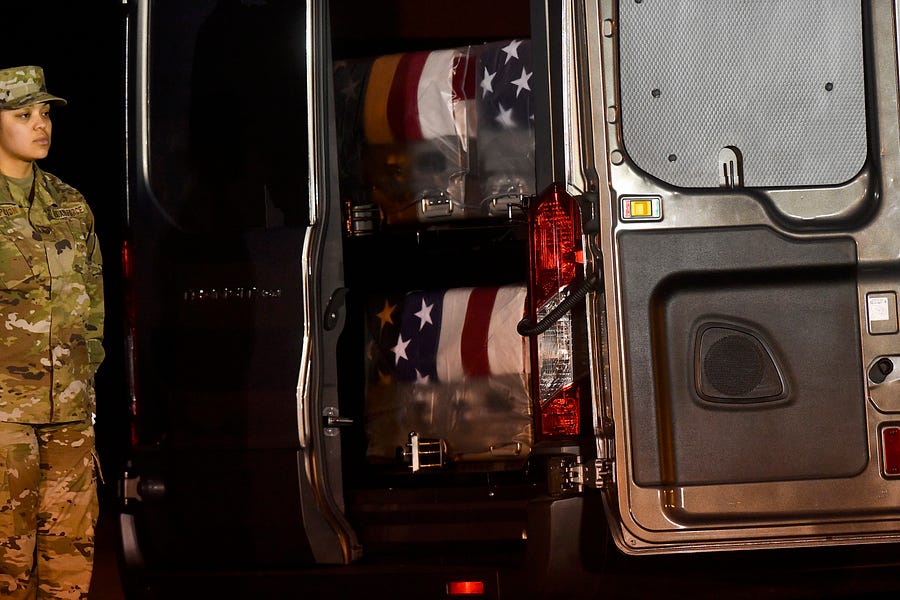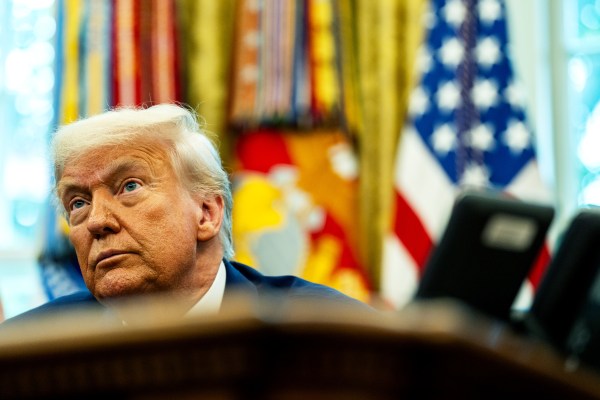Welcome to the fourth issue of Vital Interests. In our first three newsletters, I’ve focused on the “Great Power Competition” (GPC) between the U.S. and China. But I want to turn today to a topic that I’ve spent nearly two decades focused on: al-Qaeda and the war on jihadism.
I’m writing this before President Trump’s State of the Union speech. But I’m willing to wager there is not much, if anything, concerning al-Qaeda in it. We are in one of those periods when the political class isn’t chattering much about terrorism. Those moments are fleeting and offer false comfort.
And in my view, a few events warrant closer scrutiny. Let’s begin with the terrorist attack in Pensacola, Florida, late last year.
An al-Qaeda sleeper agent?
On the morning of December 6, 2nd Lt. Mohammed Saeed Alshamrani (Al-Shamrani) of the Royal Saudi Air Force walked into a building at Naval Air Station Pensacola and opened fire. Three U.S. sailors were killed and eight more Americans were wounded. More still would have perished if not for the heroic actions of Marines and sailors who jumped into the fray to help their fellow countrymen. Two unarmed Marines even attempted to confront Shamrani with a fire extinguisher. The Saudi terrorist was shot dead by deputies from the local sheriff’s department, which quickly dispatched personnel to the scene.
Within hours, evidence surfaced showing that Shamrani’s shooting rampage was likely more than just some fit of anger. He was active on social media, including Twitter, and left behind a disturbing digital trail.
On September 11 of last year, for instance, he posted on social media that “the countdown has begun.” A number of his tweets demonstrated jihadist leanings. As SITE Intelligence Group first reported, he posted a three-page “will” that denounced America for supposedly leading a global campaign against Muslims. At the end of his farewell, Shamrani paraphrased a notorious threat from Osama bin Laden, who swore that Americans wouldn’t be safe until the Palestinians lived in security and the U.S. retreated from all Muslim lands. (In reality, while al-Qaeda likes to use the Palestinian cause for rhetorical purposes, the group has had little to do with the Israeli-Palestinian conflict.)
Shamrani also visited the 9/11 Memorial the weekend after Thanksgiving. In light of the events that followed, it is likely that this wasn’t to pay his respects to al-Qaeda’s victims, but instead to celebrate the mass murderers.
While this evidence alone demonstrated Shamrani’s jihadist sympathies, there was nothing in the public record to suggest that he was working for al-Qaeda or another terrorist organization. That is, until February 2, when Al-Qaeda in the Arabian Peninsula (AQAP) released a video declaring its “full responsibility” for Shamrani’s act of terror.
The AQAP video features the group’s leader, Qasim al-Raymi, who boasted that Shamrani was, in effect, a sleeper agent. “For several years, our hero [Shamrani] moved between several U.S. military bases in America to select and contemplate his best and fattest target,” Raymi claimed. “Allah bestowed him great patience, and due to the Grace of Him alone, he passed all the military tests and all the security procedures.”
Raymi portrayed Shamrani as one in a line of other terrorists who were either inspired or directed by AQAP, including the 2009 Fort Hood Shooter, the failed Christmas Day 2009 bomber, and the 2013 Boston Marathon bombers. Raymi claimed that more terrorists are on their way and asked Muslims to honor the memory of the “courageous knight”—Mohammed Saeed al-Shamrani.
AQAP’s production doesn’t provide concrete evidence that Shamrani was known to the group before his day of terror. It is possible that this is an opportunistic claim, as AQAP has been trying to steal the limelight back from its ISIS rivals. AQAP first mass-marketed the idea of lone or individual jihad in 2010, but ISIS took this concept to a new level—inspiring or directing far more small-scale attacks around the globe since 2014. AQAP, which rejected the religious legitimacy of ISIS’s caliphate and has been fighting its Yemeni arm, is clearly cognizant of this fact. In 2017, Raymi himself implored followers to carry out “simple” attacks on behalf of his cause.
Then again, it is possible that Shamrani was indeed an AQAP sleeper agent. Two American counterterrorism officials I spoke with indicated that they think there is, in fact, more to Shamrani’s story. Which raises a simple question: Are more sleepers already here?
In the aftermath of the shooting in Pensacola, some reports suggested that Shamrani hadn’t acted alone, but was instead assisted by some of his fellow Saudi cadets. All of them were taking part in a joint training program the U.S. hosts for its allies. Some accounts indicated that other Saudis in the program filmed the shooting, presumably to celebrate the footage at a later date. According to the Department of Justice, this was not the case. Instead, the Saudis began recording at the scene only after the Americans scrambled to provide assistance to the victims. Apparently, they weren’t in on it.
On Jan. 13, Attorney General William P. Barr announced “there was no evidence” showing that any of Shamrani’s comrades had assisted him or had “pre-knowledge of the attack.” Still, the Trump administration clearly found some troubling information.
Barr explained that 21 Saudi cadets had been “dis-enrolled” from the U.S. military training curriculum and would be returned to their home country. Of these, 17 “had social media” accounts containing “some jihadi or anti-American content.” Fifteen of the 21 Saudis (including of some of those 17) also “had some kind of contact with child pornography.” And one of the 15 “had a significant number of such images.”
The Saudis and the Americans agreed that this was unseemly behavior. But none of the Saudis were charged with any crime. They merely couldn’t stay in the U.S. We may never know anything more about them.
We are still left with some troubling questions about Shamrani—namely, was he communicating with AQAP or any other al-Qaeda-affiliated terrorists overseas? The answer may be locked in Shamrani’s iPhones.
In January, Barr publicly asked Apple to unlock Shamrani’s phones, which are encrypted. Apple has thus far refused, arguing that the company has provided investigators with vital information extracted from the cloud and breaking the phones’ encryption would open the door for authoritarian governments, such as China and Russia, to do the same, but for their own nefarious anti-democratic purposes. The government ran into a similar hurdle with Apple after the December 2015 shooting in San Bernardino, California, when the terrorist couple responsible left behind encrypted communications. Apple refused to crack the phones’ security for the FBI, but the government found a private company that was willing and able to do so, thereby ending the standoff.
The issue here is that Shamrani may have been communicating with bad actors via encrypted end-to-end applications such as WhatsApp and Telegram. Both of those apps are among the jihadists’ favorites.
In the course of my own work, I follow hundreds of terrorist channels on Telegram—a popular app that can be downloaded on your phone or computer. Raymi’s video claiming “full responsibility” for Shamrani’s terror was posted on several Telegram channels. That’s one way I downloaded it. The public-facing Telegram channels are just one part of the counterterrorism problem. We still don’t know if Shamrani was using Telegram, or another platform, to communicate overseas.
Is AQAP’s leader dead?
Qasim al-Raymi, the AQAP leader who claimed responsibility for the Pensacola shooting, may already be dead. The CIA reportedly targeted Raymi in a drone strike in January. There are rumors on jihadist social media channels that he is dead, but AQAP hasn’t confirmed it yet. Neither has the U.S. government—officially, that is.
On January 31, President Trump retweeted some accounts saying that Raymi had perished in the American bombing. If true, then this is the first time the U.S. government has announced a senior terrorist’s death via retweet.
Although he was only in his early 40s, Raymi was (or is) an al-Qaeda veteran. His terrorist career began in Afghanistan prior to 9/11, when Osama bin Laden’s lieutenants identified him as a promising young recruit with leadership potential. Despite being a young man in his 20s, al-Qaeda appointed him to serve as a trainer at the infamous al-Farouq camp, where some of the 9/11 hijackers were trained. He fled Afghanistan after 9/11, making his way to his native Yemen. Raymi was eventually arrested after he was implicated in a plot to assassinate the U.S. ambassador.
In 2006, Raymi escaped from prison alongside more than 20 of his comrades. Some of these men helped rebuild AQAP. After 9/11, Osama bin Laden ordered his men to launch an insurgency inside the Saudi Kingdom. This was a disastrous move for the jihadists, as the Saudis crushed the first iteration of AQAP, forcing many of its surviving members to flee south on the Arabian Peninsula, to Yemen.
Raymi was part of a small cohort responsible for relaunching AQAP. In January 2009, he appeared in a video announcing AQAP’s rebirth. In that same video, two of his comrades explained that they were fighting to build a new Islamic caliphate. That remains AQAP’s principal goal to this day. Although many Western counterterrorism analysts came to believe that al-Qaeda was only interested in attacking America, or Europe, that was never really the case. Well before the rise of ISIS in 2014, al-Qaeda was telling its followers that one day they would reclaim Islam’s glory under the banner of a powerful, united caliphate. This empire remains a distant dream, but AQAP is seeking to build an Islamic emirate in Yemen and then Saudi Arabia, hoping to one day connect this state with other emirates in an Islamic empire.
U.S. officials have implicated Raymi in a string of plots against the West, including the failed Christmas Day bombing in 2009. That attack was carried out by a young Nigerian recruit wearing an underwear bomb, which fizzled.
It is likely that Raymi played a leadership role not just in AQAP, but also in al-Qaeda’s global management team. So, if Raymi is dead, it’d be a significant blow. But it isn’t a mortal wound for the group, as there are other al-Qaeda veterans in Yemen and elsewhere who are capable of picking up the banner. New reports underscore the ongoing threat.
United Nations warns al-Qaeda is very much alive.
It’s 2020 and we are still talking about al-Qaeda. Why? The short answer is this: Al-Qaeda has always been, first and foremost, an insurgency organization. Terrorism is one tactic the group uses to achieve its long-term goal: The resurrection of an Islamic caliphate. Even though al-Qaeda hasn’t been able to carry out another 9/11-style attack in the U.S., the group is still killing an awful lot of people around the globe. Al-Qaeda has thousands—yes, at least thousands—of dedicated fighters waging jihad on its behalf. And some of them can be tasked with terrorist attacks in the West.
In late January, the United Nations monitoring team responsible for tracking the jihadists reported that al-Qaeda “remains resilient and increasingly threatening,” despite suffering setbacks. Al-Qaeda’s regional arms are actually “stronger” than ISIS “in many conflict zones.”
It’s true: al-Qaeda has insurgent groups in Afghanistan and Pakistan, East and West Africa, Yemen, and Syria, as well as smaller organizations elsewhere. Their goal is to overturn the existing political order in their designated geographic region, and then install their draconian version of Islamic law (sharia), which would be administered by Islamic emirates. In their imagined future, these constituent states would join up in a new caliphate.
This isn’t happening any time soon. Al-Qaeda’s global insurgency is impeded by many roadblocks. And there’s no question that other American foes, such as the Chinese, are far more powerful. But after all these years, al-Qaeda is still very much alive.
Here are three other highlights from the U.N.’s report:
-
Al-Qaeda’s relations with the Taliban “continue to be close and mutually beneficial,” as al-Qaeda provides its long-time blood brothers with “resources and training in exchange for protection.” In September, one of the most senior al-Qaeda leaders in Afghanistan was killed in a Taliban stronghold, where he and others were protected by the Taliban’s “shadow governor.” Why does this matter? Well, as I explained in a separate piece for The Dispatch, the Trump administration has pitched a deal with the Taliban in which the group would be America’s de facto counterterrorism partner after supposedly cutting off its ties to al-Qaeda. The State Department hasn’t explained how this could be verified. Moreover, months after the Taliban provided the State Department with its proposed counterterrorism assurances, al-Qaeda and affiliated groups remain deeply embedded within the Taliban. Indeed, al-Qaeda is fighting to resurrect the Taliban’s Islamic Emirate of Afghanistan. The U.N.’s new report is just the latest piece of evidence along these lines. Contrary to the prospective deal Secretary of State Mike Pompeo has endorsed, the U.N. warns that the al-Qaeda-affiliated foreign jihadists fighting under the Taliban’s banner “pose a long-term global threat.”
-
Al-Qaeda has thousands of fighters in northwestern Syria and some of them continue to pose a threat to the West, but the war may have them boxed in for now. Syria’s Idlib province “remains dominated by groups affiliated with al-Qaeda,” the U.N. monitoring team reports, and some of these “elements” want “to plan and execute international attacks.” However, their terrorist ambitions are likely “curtailed both by the military pressure they are under and by al-Qaeda’s reluctance to resource such activity.” Al-Qaeda has encountered a lot of problems in Syria. Its initial goal was to lay the groundwork for an Islamic emirate after Bashar al-Assad’s regime was toppled. Now the jihadists are clinging to territory as Assad and his foreign allies, the Russians and Iranians, pummel Idlib province.
-
Al-Qaeda’s affiliate in East Africa, Shabaab, continues to lay the groundwork for its own Islamic emirate in Somalia. The fledgling government of Somalia, backed by the U.S. and other allies, is holding Shabaab at bay—for now. But the group remains prolific. And according to the UN’s monitoring team, Shabaab operates an “elaborate taxation system” while extorting cash from local businesses and telecommunications companies. The largest telecom in the area is “expected to remit about $200,000 per month.”
There is much more in the U.N.’s report, including additional details concerning ISIS—which broke off from al-Qaeda and became its most significant jihadist rival. The U.N. report shouldn’t be treated as Gospel truth. Not all of it rings true to me, but much of it does. The three parts I highlighted above are all corroborated by other evidence.
The U.S. government wants to focus on “Great Power Competition” (GPC)—not the 9/11 wars, meaning those conflicts unleashed by al-Qaeda’s deadliest day and its aftermath.
While there’s much to be said for GPC, there is a persistent terrorist threat. How the U.S. manages it is up for debate. In future editions of Vital Interests, I’m going to tackle the rhetoric surrounding America’s “endless wars.” While there is plenty to criticize about the wars in Afghanistan, Iraq and elsewhere, I think this phrasing is deceptive. It implies that the 9/11 wars are purely a function of America’s policies (some of which have exacerbated the terrorist problem), but doesn’t say anything about the terrorists, or their capacity for violence. In other words, we should always remember that the enemy gets a vote—just not in the 2020 U.S. presidential election.






Please note that we at The Dispatch hold ourselves, our work, and our commenters to a higher standard than other places on the internet. We welcome comments that foster genuine debate or discussion—including comments critical of us or our work—but responses that include ad hominem attacks on fellow Dispatch members or are intended to stoke fear and anger may be moderated.
With your membership, you only have the ability to comment on The Morning Dispatch articles. Consider upgrading to join the conversation everywhere.